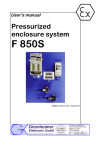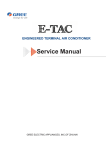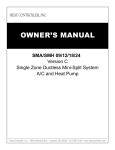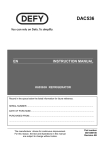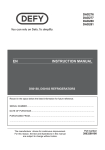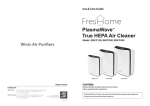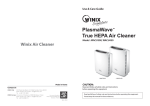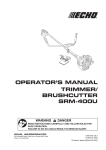Download Haier HRZ-186AA refrigerator
Transcript
HRZ-186AA
8QGHU&RXQWHU)ULGJH
'
Thank you for buying this Haier refrigerator. To ensure that you get the best results from your
new fridge, please take time to read through these simple instructions in this booklet.
Please ensure that the packaging material is disposal of in accordance with the current
environmental requirements.
If the appliance is visibly damaged, do not connect it to the power supply, contact the store from
where you purchased the appliance.
For your safety please read the following information.
The appliance must be connected to a 220 - 240 volts 50 cycle AC supply by means of a three pin
socket, suitably earthed and should be protected by a 13 amp fuse in the plug.
The appliance is supplied with a standard 13 amp 3-pin plug fitted with a 13-amp fuse.
Should the fuse require replacement, it must be replaced with a fuse rated at 13 amp and approved
to BS1362.
If the mains plug is unsuitable for the socket outlet in your home or is removed for any other
reason, then the cut off plug should be disposed of safely, do not insert the cut off plug into a
mains outlet to prevent the hazard of electric shock. Remove the fuse before disposal.
There is a danger of electric shock if the cut off plug is inserted into any 13-amp socket outlet.
How to wire a 13 amp plug:
Important
The wires in the mains lead on this appliance are colored in accordance with the following code:
Green and Yellow - Earth
Blue – Neutral
Brown – Live
As the colours may not correspond with the markings identifying the terminals in your plug
proceed as follows.
The green and yellow wire must be connected to the terminal in the plug which is marked with the
letter E or with the earth symbol
or colored green and yellow.
The blue wire must be connected to the terminal marked N.
The brown wire must be connected to the terminal marked L.
You must make sure the mains cord is firmly secured under the cord clamp.
%
"
!
"
"
"
"
"
%
"
"
&
"
"
$
"
"
#
"
"
"
#
"
"
"
%
$
$
!
!
&
"
"
"
&
$
"
$
"
#
$
"
"
&
2
"
"
$
"
$
#
'
(
)
*
+
,
-
.
/
-
0
1
.
0
2
(
)
3
4
*
5
'
(
4
3
(
)
4
6
0
1
0
-
7
.
2
'
This booklet contains the information you will require to install and operate your new
appliance.
It is important and worthwhile spending time to fully read this booklet so you will
understand how to operate the appliance safely and efficiently.
Please keep this booklet in a safe place so that you can refer to it when required.
3
8
9
:
;
<
=
>
9
?
@
A
8
;
=
?
>
This information is provided in the interest of your safety. Please read the following
carefully before carrying out the installation or use of the appliance.
If you are discarding an old freezer or refrigerator with a lock / catch fitted to the
door, ensure that it is left in a disabled condition to prevent the entrapment of young
children when playing.
As old refrigeration equipment may contain CFC’s which will damage the ozone
layer, when disposing of any refrigeration equipment please contact your local waste
disposal department for advice on the correct method of disposal
This appliance must only be used for its intended purpose i.e. the storage of domestic
edible foodstuffs and should not be used for any other purpose
If the mains cable becomes damaged, it must be replaced by the manufacturer, its
service agent or a similarly qualified person to avoid a hazard.
4
>
B
;
8
C
C
8
;
=
?
>
Position the appliance and allow to stand for two to three hours before it is turned on
for the first time to allow the system to settle. Do not position next to any heat source
e.g. cooker, boiler or in direct sunlight etc.
A clearance of 10 cm must be left between the sides of the appliance and any adjacent
cabinets or walls to allow for adequate air circulation. The appliance is not designed
for recessed installation (“building in”).
Install on a good firm level surface, and any unevenness of the floor should be
corrected prior to installation, slight unevenness can be overcome by adjusting the
front feet.
NOTE: If the appliance is positioned on a carpet, soft floor covering you should readjust the front feet once the appliance has had time to settle.
3
,03257$176$)(7<,1)250$7,21
7KLVDSSOLDQFHPXVWEH XVHGRQWKHHO HFWULFYROWDJHVKRZQRQWK HUDWLQJ SODWH,
IDLOXUHWRXVHWKH FRUUHFWYROWDJH ZLOOUHQGHUWKHJXDUDQWHH92,' and may cause
damage to the product
D
E
N
E
F
G
H
M
I
X
I
H
R
J
R
F
H
H
K
K
N
L
M
U
F
H
K
G
F
O
K
S
N
M
F
K
Y
O
E
M
N
O
P
Z
M
Q
O
R
O
H
K
Q
Y
S
M
M
R
Q
G
N
T
F
G
L
T
G
M
Q
K
J
U
V
H
K
U
Q
N
E
M
R
T
G
M
S
H
U
F
K
W
H
J
F
O
H
N
M
[
7KLVDSSOLDQFHLVLQWHQGHGIRULQGRRUXVHRQO\GRQRWXVHRXWGRRUV
\
L
N
F
L
S
M
M
G
G
G
F
Z
J
M
G
T
R
P
H
L
M
G
S
H
U
Y
M
N
E
Q
N
O
T
R
F
K
Y
Q
I
M
R
H
N
F
Q
K
V
T
G
M
E
H
K
O
J
M
G
H
K
O
]
K
Q
Z
G
H
N
H
J
J
[
7RSURWHFWDJ DLQVWHO HFWULF VKRFNGRQ RWLPPHUVH FRUGSOXJ VRUD SSOLDQFHL Q
ZDWHURURWKHUOLTXLG
Warning: Keep ventilation openings, in the appliance enclosure or in the
built-in structure, clear of obstruction.
8QSOXJIURP RXWOHWZKHQ QRWLQX VHDQGEHI RUHFOHDQLQJ Remove foodE HIRUH
FOHDQLQJWKHDSSOLDQFH
,IWKHPDLQVOHDGEH FRPHVGDPDJHGLWPXVWEHUHSODFHGE\WKHPDQXID FWXUHU
LWVVHUYLFHDJHQWRUVLPLOD UO\TXDOLILHG SHUVRQZLWKDOHDGRIWKHVDPHW\SHDQG
UDWLQJWRDYRLGDKD]DUG
Do not operate the appliance with a damaged cord or plug or after the
appliance malfunctions or has been damaged in any way. Consult the retail
store where you bought the appliance for advice.
The cooling circuit must not be damaged in any way.
Warning: Do not use mechanical devices or other means to accelerate the defrost
process, other than those recommended by the manufacturer.
Warning: Do not damage the refrigerant circuit.
'RQ RWSODFH the DSSOLDQFHQ HDU KRW surfacesR ULQ direct sunlight
([WUHPHFDXWLRQPXVWEHXVHGZKHQPRYLQJDQDSSOLDQFH, the appliance may be
heavy.
Warning: Do not use electrical appliances inside the food storage compartment of
the appliance, unless they are of the type recommended by the manufacturer.
4
Instructions for use
Remove all packing materials and wash the interior of the appliance using lukewarm
water containing a little bicarbonate of soda in the proportion of 1 teaspoon to 1.2 liters
(2 pints) of water. Do not use detergents or soaps as they may taint the food. After
cleaning, dry all parts thoroughly.
Temperature Control
The refrigerator is designed to maintain an internal storage temperature in the
refrigerator compartment between
to +
.
To enable adjustment of the temperature in the appliance it is fitted with an adjustable
thermostat located in the fridge compartment, which can be adjusted from setting 1
(warmest) to 7 (coldest). For normal working temperature it is recommended to adjust
the thermostat control to the midway position, after a few hours readjust the thermostat
to the desired temperature. There is also an off position 0 . Which turns OFF the
refrigerator and freezer compartments. Please Note this dose not disconnect the
appliance from the mains supply. To do this you must remove the mains plug from the
socket.
To obtain a lower internal temperature turn the thermostat temperature control to a
higher number. To obtain a higher internal temperature turn the thermostat control
to a lower number. However, the internal temperature and temperature control
setting is dependent on a number of factors:
1. Varying ambient temperatures.
2. The number of times the appliance doors are opened and how long the doors remain
open.
3. The amount and temperature of the food and drink introduced into the appliance.
4. The weather conditions and time of year e.g. summer / winter.
5. The positioning of the appliance and an adequate air circulation to the sides and
back of the cabinet.
Never place hot or warm foods into the cabinet or leave the doors open for longer than
necessary as this will raise the temperature and cause excessive amounts of moisture thus
increasing the amount of ice in the refrigerator / freezer compartment.
The Internal Light
The internal light will automatically switch ON and OFF whenever the refrigerator door
is opened or closed. To change the light bulb, please see the chapter on changing the light
bulb.
5
Storage of fresh food in the refrigerator
Food should always be covered tightly with foil, plastic film, placed in bags or stored in
airtight containers. This will prevent food from dehydrating and prevent the strong smell
of some foods transferring to milder ones.
To store raw meat wrap in polythene bags or airtight containers and place on the
lowest shelf.
Do not allow raw meat to come into contact with cooked foods. For safety, only store raw
meat for two or three days. Fruit and vegetables should be thoroughly cleaned and
placed in the vegetable/ salad bin.
Milk and other liquids should be sealed with lids and placed in the bottle shelf on the
door.
5HIULJHUDWRUGHIURVWSURFHVV
5HIULJHUDWRUGHIURVWSURFHVV7KHUHIULJHUDWRUGHIURVWLQJSURFHVVLVFDUULHGRXWDXWRPDWLFDOO\
HYHU\WLPHWKHFRPSUHVVRUVWRSV7KHGHIURVWZDWHUGUDLQVIURPWKHFDELQHWLQWRDWUD\
SODFHGRQWKHWRSRIWKHFRPSUHVVRUWRWKHUHDURIWKHXQLWZKHUHLWHYDSRUDWHV$ZD\V
HQVXUHWKHGUDLQKROHGRHVQRWEHFRPHEORFNHGZLWKIRRGWKHGUDLQKROHLVORFDWHGLQVLGH
WKHUHIULJHUDWRUWRWWKHUHDURIWKHXQLWMXVWDERYHWKHFULVSHUFRYHU
6
Cleaning and maintenance
Before any cleaning or maintenance is carried out you must disconnect the appliance
from the mains supply by removing the plug, never remove the plug by pulling on the
mains cord. Remove the plug by pulling on the plug itself.
It is recommended that when cleaning the appliance, both the inside and outside, can be
cleaned using warm water and a little bicarbonate of soda. Use 1 teaspoon to 1.2 litres
of water.
If the appliance is not to be used for a long period of time then it is recommended to
remove all the food stuff, clean the inside of the appliance and leave the door open to
allow the air to circulate thus avoiding unpleasant odors.
Changing the light bulb
Note. Light bulbs are not covered by the warranty
Disconnect the appliance from the mains supply.
Pull the lamp cover forwards, to gain accesses to the lamp . Unscrew the light
bulb in an anti-clockwise direction from the holder.
Replace the bulb with one of the correct type and size (10 watt E14 base).
Replace the cover by Pushing the cover Backwards.
Reconnect the appliance to the mains supply.
.
The condenser is the wire pipe work fitted to the rear of the appliance, this condenser must
be cleaned periodically by using a stiff brush or vacuum clearner.
This will ensure correct operation and will save energy, always unplug the appliance before
any cleaning operation.
.
If the appliance is not operating correctly:
Please check the following points.
Is there a power failure? (Check by turning on a house light)
Has the fuse blown or has the circuit breaker tripped.
Has the door been closed correctly?
Check the thermostat has been set correctly.
Check the mains plug is seated in the wall socket correctly and the socket switch is on.
Check the power outlet is working, Try another appliance.
Is the room temperature too cold or too hot. ( working temperature range 16 to 32 )
If the refrigerator is not in use for a long period of time, proceed as follows:
Disconnect the refrigerator from the main supply by removing the plug from the socket.
Clean and dry the inside as instructed under the heading of cleaning the appliance.
Leave the door open to prevent any unpleasant smells from building up while the
appliance is not in use.
Before calling for service
Please check the following points:
1. The refrigerator is noisy when running
Check the appliance is level and is not in contact with another appliance or kitchen
furniture.
2. The refrigerator does not cool sufficiently.
If the door has been opened too often, or it has been left open for a while it will take
time for the appliance to reach its set temperature.
Check the air flow around the refrigerator has not been reduced due to insufficient
clearance.
NOTE: The following characteristics should not be looked upon as a problem.
A gentle trickling sound caused by coolant flowing through the pipe.
Compressor operating at high temperature.
Do's and on'ts
Do- keep raw meat and poultry below cooked food and dairy products.
Do- Leave lettuce, cabbage, parsley and cauliflower on the stem.
Do- Wrap cheese firstly in greaseproof paper and then in a polythene bag, excluding As
much air as possible. For best results, take out of the fridge compartment an hour before
eating.
Do- Wrap raw meat and poultry loosely in polythene or aluminium foil. This prevents
drying.
Do- Wrap fish and offal in polythene bags.
Do- Wrap food with a strong odour or which may dry out, in polythene bags, or
aluminium foil or place in airtight container.
Do- Wrap bread well to keep it fresh.
Do- Chill white wines, beer, larger and mineral water before serving.
Do- Check contents of the low temp compartment every so often.
Do- Keep food for as short a time as possible and adhere to "Best before" and "Use by"
etc. dates.
Do- Store commercially prepared food in accordance with the instructions given on the
packets.
Do- Always choose high quality fresh food and be sure it is thoroughly clean before
Storing it.
Do- Wrap all food in aluminium foil or food quality polythene bags and make sure any
air is excluded.
Do-Keep ventilation openings, in the appliance enclosure clear of obstruction.
Do-ensure that frozen food does not rise in temperature while defrosting, a rise in
temperature during defrosting may shorten the storage life of your food.
Don't- Cover the shelves with any protective materials which may obstruct air circulation.
Don't- Store poisonous or any dangerous substances in your fridge. It has been
designed for the storage of edible foodstuffs only.
Don't- Consume food which has been refrigerated for an excessive length of time.
Don't- Store cooked and fresh food together in the same container. They should be
packaged and stored separately.
Don't- Let defrosting food or food juices drip onto already stored food.
Don't- leave the door open for long periods, as this will make the appliance more costly
to run and cause excessive ice formation.
Don't- Use sharp edged objects such as knives or forks to remove the ice.
Don't- Use hairdryers, or electrical appliances for defrosting only use item
recommended by the manufacturer.
Don't- put hot food into the appliance. Let it cool down first.
Don't- put liquid-filled bottles or sealed cans containing carbonated liquids into the
freezer section, as they may burst.
Don't- Give children ice cream and water ices direct from the freezer section. The low
temperature may cause 'freezer burns' on the lips.
Don't- Try to keep frozen food which has thawed; it should be eaten within 24 hours or
cooked and refrozen.
Don't- Damage the refrigerant circuit at any time
9ROWDJHIUHTXHQF\9a+]
Product H x W x D(cm): 85x55x58
&DUWRQ+[:['FP[[
Weight net / gross: 30 / 33 kg
7RWDOVWRUDJHYROXPH˖ /
(QHUJ\FODVV$
(QHUJ\FRQVXPSWLRQN:K<HDU
&OLPDWHFODVV1 7KHUPRVWDWDGMXVWPDQXDO
5HYHUVLEOHGRRU
)URQWDGMXVWDEOHIHHW
&RORXUZKLWH
5HIULJHUDQW5$
0D[QRLVHOHYHO G%
/HQJWKRIFDEOHLQFOSOXJPHWUHV
^
Ϭ
9ROWDJHIUHTXHQF\9a+]
Product H x W x D(cm): 85x55x58
&DUWRQ+[:['FP[[
Weight net / gross: 30 / 33 kg
7RWDOVWRUDJHYROXPH˖ /
(QHUJ\FODVV$ (QHUJ\FRQVXPSWLRQ N:K<HDU
&OLPDWHFODVV1 7KHUPRVWDWDGMXVWPDQXDO
5HYHUVLEOHGRRU
)URQWDGMXVWDEOHIHHW
&RORXUZKLWH
5HIULJHUDQW5$
0D[QRLVHOHYHO G%
/HQJWKRIFDEOHLQFOSOXJPHWUHV
_
Ϭ
`
a
b
c
d
e
f
g
e
h
`
i
b
c
i
f
f
j
m
`
n
o
g
p
i
m
q
e
r
d
s
k
m
t
l
u
v
e
p
`
o
p
c
w
g
n
t
i
v
p
o
x
p
y
n
o
p
n
u
r
z
w
w
{
p
p
s
|
t
o
r
s
}
p
s
w
~
As such we urge you to follow the correct disposal procedure for your product
and packaging materials. This will help conserve natural recourses
and ensure that it is recycled in a manner that protects health and the
environment.
You must dispose of this product and its packaging according to local laws
and regulations. Because this product contains electronic components and
sometimes batteries, the product and its accessories must be disposed of
separately from household waste when the product reaches its end of life.
Contact your local authority to learn about disposal and recycling.
The product should be taken to your local collection point for recycling.
Some collection points accept products free of charge.
1














